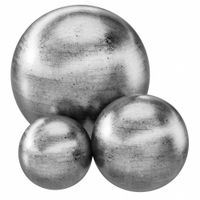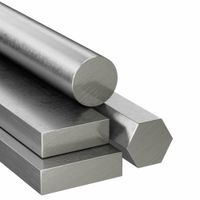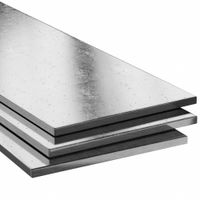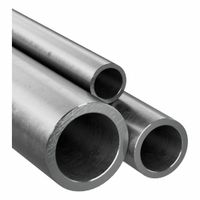Call +(254) 703 030 000 / 751 483 999 / 721 704 777
- Home
- Raw Materials
- Metals
- Alloy Steel
.....Read More
Frequently Asked Questions
What is alloy steel and what are its properties?
Alloy steel is a type of steel that is alloyed with a variety of elements in total amounts between 1.0% and 50% by weight to improve its mechanical properties. The elements commonly used in alloy steel include manganese, nickel, chromium, molybdenum, vanadium, silicon, and boron. These elements are added to enhance certain properties such as strength, hardness, toughness, wear resistance, and corrosion resistance.
Properties of alloy steel vary depending on the specific elements and their concentrations. Some key properties include:
1. **Strength and Hardness**: Alloy steels are generally stronger and harder than carbon steels. Elements like chromium and molybdenum increase tensile strength and hardness, making them suitable for high-stress applications.
2. **Toughness**: The addition of elements such as nickel and manganese improves toughness, allowing the steel to absorb energy and resist impact without fracturing.
3. **Wear Resistance**: Alloy steels often exhibit superior wear resistance due to the presence of hard carbides formed by elements like chromium and vanadium.
4. **Corrosion Resistance**: Certain alloy steels, particularly those with high chromium content, offer enhanced resistance to corrosion and oxidation, making them ideal for use in harsh environments.
5. **Heat Resistance**: Alloy steels can maintain their strength and hardness at elevated temperatures, which is beneficial for applications involving high heat, such as in power plants and engines.
6. **Machinability and Weldability**: While some alloy steels are more challenging to machine and weld due to their hardness, others are designed to offer good machinability and weldability, depending on the specific application requirements.
Overall, alloy steels are versatile materials used in a wide range of industries, including automotive, aerospace, construction, and manufacturing, due to their enhanced mechanical properties and adaptability to various conditions.
What are the common applications of alloy steel?
Alloy steel, known for its enhanced properties due to the addition of various elements, finds applications across numerous industries. Here are some common applications:
1. **Automotive Industry**: Alloy steel is used in the manufacturing of gears, shafts, axles, and engine components due to its strength and wear resistance. It is also used in the production of high-strength fasteners and suspension components.
2. **Construction**: In construction, alloy steel is utilized for structural components like beams, columns, and reinforcements. Its high tensile strength and durability make it ideal for building bridges, skyscrapers, and other infrastructure.
3. **Aerospace**: The aerospace industry uses alloy steel for aircraft landing gear, engine components, and structural parts. Its ability to withstand high stress and temperature variations is crucial for aviation safety and performance.
4. **Energy Sector**: Alloy steel is employed in the energy sector for pipelines, pressure vessels, and drilling equipment. Its corrosion resistance and ability to withstand high pressure and temperature make it suitable for oil and gas exploration and power generation.
5. **Tool Manufacturing**: Due to its hardness and resistance to deformation, alloy steel is used in making cutting tools, dies, and molds. It ensures precision and longevity in manufacturing processes.
6. **Railway Industry**: Alloy steel is used in the production of rails, wheels, and other components due to its wear resistance and ability to handle heavy loads.
7. **Shipbuilding**: In shipbuilding, alloy steel is used for hulls, propellers, and other components that require strength and resistance to harsh marine environments.
8. **Military Applications**: The defense sector uses alloy steel for armor plating, weaponry, and military vehicles due to its toughness and impact resistance.
These applications leverage the enhanced mechanical properties of alloy steel, such as increased strength, toughness, and resistance to wear and corrosion, making it a versatile material in various industries.
How does alloy steel differ from carbon steel?
Alloy steel and carbon steel differ primarily in their composition and properties.
Carbon steel is composed mainly of iron and carbon, with carbon content typically ranging from 0.05% to 2.0%. It may contain small amounts of other elements like manganese, silicon, and copper. The properties of carbon steel are largely determined by its carbon content. Higher carbon content increases hardness and strength but reduces ductility and weldability. Carbon steel is generally less expensive and is used in applications where high strength and hardness are not critical.
Alloy steel, on the other hand, contains additional alloying elements such as chromium, nickel, molybdenum, vanadium, and tungsten, in varying proportions. These elements are added to enhance specific properties like strength, hardness, corrosion resistance, and toughness. For example, chromium increases corrosion resistance, while nickel enhances toughness. The presence of these alloying elements allows for a wider range of mechanical properties and makes alloy steel suitable for more demanding applications, such as in the automotive, aerospace, and construction industries.
In summary, the key difference lies in the composition: carbon steel is primarily iron and carbon, while alloy steel includes additional elements to improve specific properties. This results in alloy steel having superior performance characteristics compared to carbon steel, making it more suitable for specialized applications.
What are the different grades of alloy steel?
Alloy steel is categorized based on the alloying elements and their concentrations, which influence the steel's properties. The main grades of alloy steel include:
1. **Low-Alloy Steel**: Contains a total alloying element content of less than 5%. Common elements include chromium, molybdenum, and nickel. These steels are known for their improved mechanical properties and resistance to wear and corrosion compared to carbon steel.
2. **High-Strength Low-Alloy (HSLA) Steel**: Designed to provide better mechanical properties and greater resistance to atmospheric corrosion than conventional carbon steel. HSLA steels are typically used in structural applications and contain small amounts of alloying elements like vanadium, niobium, and titanium.
3. **Chromium-Molybdenum Steel (Cr-Mo Steel)**: Known for its high strength, toughness, and resistance to wear and corrosion. It is commonly used in the manufacturing of pressure vessels and pipelines.
4. **Nickel Steel**: Contains nickel as a primary alloying element, which enhances toughness and impact resistance. It is often used in applications requiring high strength and toughness at low temperatures.
5. **Stainless Steel**: Contains a minimum of 10.5% chromium, which provides excellent corrosion resistance. Stainless steels are further divided into austenitic, ferritic, martensitic, duplex, and precipitation-hardening grades, each with distinct properties and applications.
6. **Tool Steel**: Contains varying amounts of tungsten, molybdenum, cobalt, and vanadium, which enhance hardness and heat resistance. Tool steels are used for cutting, pressing, extruding, and coining metals and other materials.
7. **Maraging Steel**: Known for its ultra-high strength and toughness, achieved through aging heat treatment. It contains elements like nickel, cobalt, and molybdenum and is used in aerospace and tooling applications.
Each grade of alloy steel is tailored for specific applications, balancing properties like strength, ductility, toughness, and resistance to wear and corrosion.
How is alloy steel manufactured?
Alloy steel is manufactured through a series of steps that involve the combination of iron with various alloying elements to enhance its properties. The process begins with the selection of raw materials, primarily iron ore, which is smelted in a blast furnace to produce pig iron. This pig iron is then refined in a basic oxygen furnace or an electric arc furnace to reduce carbon content and remove impurities.
Once the base steel is prepared, alloying elements such as chromium, nickel, manganese, molybdenum, vanadium, and others are added. These elements are introduced in specific proportions to achieve desired mechanical properties like strength, hardness, corrosion resistance, and toughness. The addition of these elements can occur during the initial melting process or in a secondary refining stage.
The molten alloy steel is then cast into various forms, such as ingots, billets, or slabs, depending on the intended final product. These cast forms undergo further processing through hot or cold rolling to achieve the desired shape and size. During rolling, the steel is subjected to heat treatment processes like annealing, quenching, and tempering to refine its microstructure and enhance its mechanical properties.
Quality control measures are implemented throughout the manufacturing process to ensure the alloy steel meets specified standards. This includes chemical analysis, mechanical testing, and inspection for defects.
Finally, the finished alloy steel products are cut, shaped, and sometimes coated or treated for specific applications in industries such as automotive, construction, aerospace, and machinery. The entire process is carefully controlled to produce alloy steel with the precise characteristics required for its intended use.
What are the advantages of using alloy steel?
Alloy steel offers several advantages due to the addition of various alloying elements such as chromium, nickel, molybdenum, vanadium, and manganese. These elements enhance the properties of steel, making it suitable for a wide range of applications.
1. **Improved Strength and Hardness**: Alloying elements increase the tensile strength and hardness of steel, making it more durable and resistant to wear and tear. This is particularly beneficial in construction and manufacturing industries where materials are subjected to high stress.
2. **Enhanced Corrosion Resistance**: Elements like chromium and nickel improve the corrosion resistance of steel, making it ideal for use in environments exposed to moisture and chemicals, such as marine applications and chemical processing plants.
3. **Better Heat Resistance**: Alloy steels can withstand higher temperatures without losing their structural integrity, making them suitable for high-temperature applications like power plants and automotive engines.
4. **Increased Toughness**: The addition of elements such as vanadium and molybdenum enhances the toughness of steel, allowing it to absorb energy and resist fracture, which is crucial in applications like bridges and heavy machinery.
5. **Improved Machinability and Weldability**: Certain alloying elements improve the machinability and weldability of steel, facilitating easier fabrication and assembly in industrial processes.
6. **Versatility**: Alloy steels can be tailored to meet specific requirements by adjusting the type and amount of alloying elements, providing flexibility in design and application across various industries.
7. **Cost-Effectiveness**: Despite being more expensive than carbon steel, the enhanced properties of alloy steel can lead to longer service life and reduced maintenance costs, offering overall cost savings in the long term.
These advantages make alloy steel a preferred choice in industries such as automotive, aerospace, construction, and energy.
How do you select the right alloy steel for a specific application?
To select the right alloy steel for a specific application, consider the following factors:
1. **Mechanical Properties**: Determine the required strength, toughness, hardness, and ductility. Applications demanding high strength and wear resistance might require high-carbon or chromium-molybdenum steels.
2. **Corrosion Resistance**: For environments prone to corrosion, select alloy steels with elements like chromium, nickel, or molybdenum, which enhance resistance.
3. **Temperature Resistance**: High-temperature applications need steels with elements like tungsten or molybdenum to maintain strength and stability.
4. **Weldability**: If welding is necessary, choose steels with lower carbon content to prevent weld cracking. Consider steels with added elements like silicon or manganese to improve weldability.
5. **Machinability**: For applications requiring extensive machining, select steels with sulfur or lead additives to enhance machinability.
6. **Cost**: Balance performance requirements with budget constraints. High-alloy steels offer superior properties but at a higher cost.
7. **Availability**: Ensure the chosen alloy is readily available in the required form and size to avoid delays.
8. **Standards and Specifications**: Adhere to industry standards (e.g., ASTM, SAE) to ensure compatibility and performance.
9. **Thermal Treatment**: Consider the steel's response to heat treatment processes like quenching and tempering, which can alter mechanical properties.
10. **Environmental Conditions**: Assess exposure to chemicals, moisture, or extreme temperatures, which can influence alloy selection.
11. **Application-Specific Requirements**: Consider specific needs such as magnetic properties, electrical conductivity, or weight constraints.
By evaluating these factors, you can select an alloy steel that meets the specific demands of your application, ensuring optimal performance and longevity.




